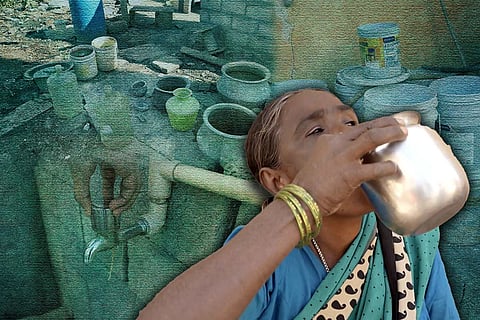

Despite a looming water crisis in the city, the Bangalore Water Supply and Sewerage Board (BWSSB) is yet to come up with a substantial plan to address the situation. A BWSSB official said they have some contingency plans in place, such as borewell revival, to combat the crisis. “Further plans and decisions,” the official added, “will be formulated reactively as the situation unfolds.” Amid significant water shortages, the agency’s approach seems to lack adequate foresight and strategic planning.
Bengaluru, which currently receives 1,450 million litres per day (MLD) of water from the Cauvery River in addition to the water from borewells, faces a substantial shortfall of 1,680 MLD. The BWSSB has identified up to 257 areas as being at risk of water scarcity. Despite this glaring deficit, the Board’s approach seems to hinge primarily on borewell revival, a strategy that experts argue is counterproductive and unsustainable.
BWSSB chairperson Ram Prasath Manohar V said that out of the city's 10,955 borewells, 1,214 have dried up completely, with an additional 3,700 experiencing significant reductions in water levels. “Efforts are underway to identify and repair borewells, as well as explore options for redrilling,” he said.
Detailing the actions undertaken by BWSSB to address the water needs of the 110 villages lacking access to Cauvery water, Ram Prasath said they will provide potable water through BWSSB’s 68 existing tankers. “We will also procure 18 new tankers and hire additional 200 private tankers to meet the demand during this summer,” he added.
TNM recently visited Ramagondanahalli, one of the 110 villages swallowed by BBMP in its 2007 expansion, and reported how the disparity in water access disproportionately affects the poor as the Cauvery network fails to reach them. Read here.
We also found that residents of Whitefield were compelled to shell out between Rs 1,800 to Rs 2,000 for 12,000 litres of water from tankers.
Criticising BWSSB’s initiative to redrill borewell, Urban Planner Vishwanath S told TNM, “Groundwater tables have already depleted as borewells are dry. We will end up drilling borewells that will be dry; or even if the borewell strikes water, it will dry other borewells in the area. The net gain to society is not likely to be anything large at all, while tons of money will be wasted.”
He instead advocated for sustainable solutions like aquifer recharge through treated wastewater. He stressed the need to prioritise initiatives that replenish aquifers and recharge lakes, rather than further exploit groundwater resources. “The money is better spent in taking treated wastewater and filling our lakes so that it recharges the aquifer. Aquifer filling is the way to go. Not drilling borewells to extract more water,” he said.
“If Bellandur and Varthur lakes (currently dry) are filled with treated wastewater, it will have an impact zone of 12 to 14 kms and all the borewells in that area will come back to life. That way the private water tankers will be able to supply water at much cheaper costs. We should seize these pockets of lakes which are still dry, and fill them with the treated wastewater from 34 wastewater treatment plants that we have,” Vishwanath said.
BWSSB’s enforcement of penalties on property owners for non-compliance with rainwater harvesting (RWH) regulations is a step in the right direction, but it appears insufficient in addressing the systemic challenges underlying the water crisis. The property owners who failed to install RWH systems face a penalty equivalent to 50% of their water bill.
“If rainwater harvesting is a law, people should follow it and make sure that they collect all the rainwater and either store/recharge it and use it. If more and more citizens — and apartments — install RWH systems, the problem of groundwater depletion will be mitigated to some extent. The penalty is one way to address it, but I think we should show maturity as citizens of the city and take responsibility,” Vishwanath said.
In response to mounting concerns, Deputy Chief Minister DK Shivakumar recently announced that Cauvery phase 5 would be operational from May. The BWSSB chairperson also expressed optimism that the upcoming Cauvery Phase 5 project would alleviate the city’s water woes for the next two to three years.
But Vishwanath cautions that while these measures may offer temporary relief, they fail to address the root causes of the crisis. He also said that Cauvery Phase 5 would mitigate the issue to some extent, even as he pointed to the persistent challenges in low-income and peripheral areas.
“With Cauvery phase 5, the issue will be relieved to a great extent. Up to 775 MLD of water will be provided if BWSSB is able to distribute it at 100 litres per capita per day. This means about 7.75 lakh people will get water,” he said. “But there would still be pockets of insufficiency, especially in the periphery and in pockets which are low income.”